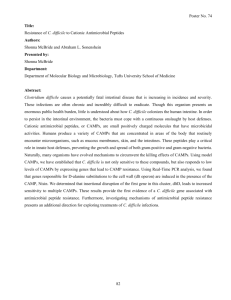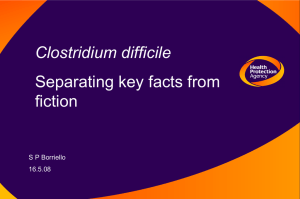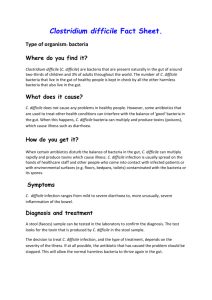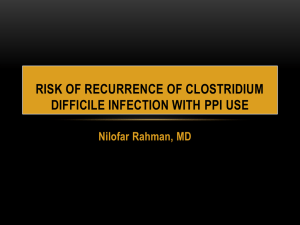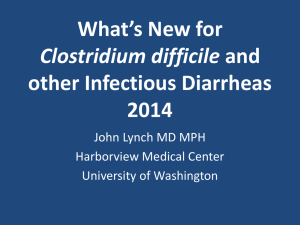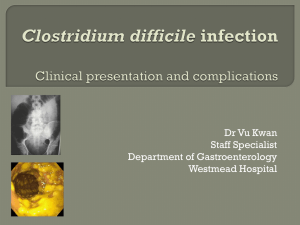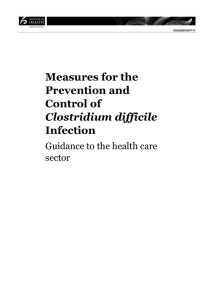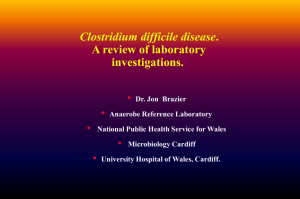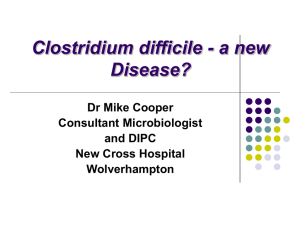Flushing Hospital Medical Center - Quality Improvement Organizations
advertisement
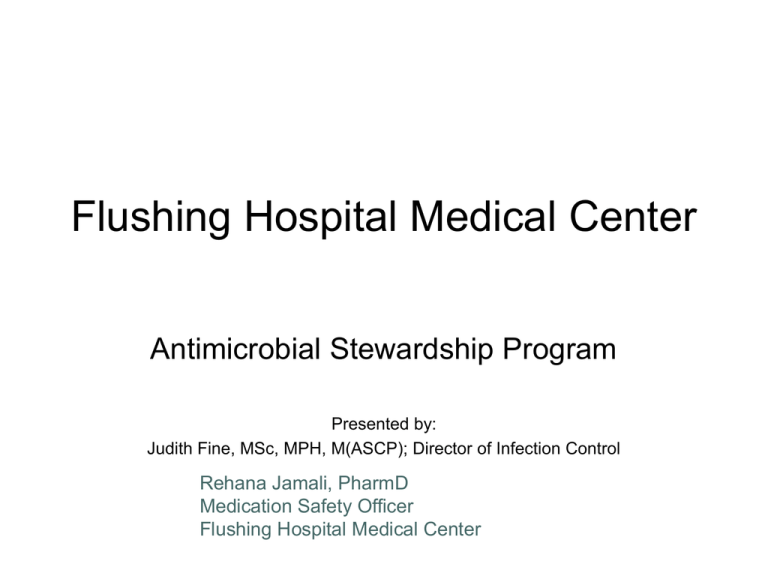
Flushing Hospital Medical Center Antimicrobial Stewardship Program Presented by: Judith Fine, MSc, MPH, M(ASCP); Director of Infection Control Rehana Jamali, PharmD Medication Safety Officer Flushing Hospital Medical Center Flushing Hospital • • • • • • • • • Local Community Hospital incorporated since 1884. Certificate of Occupancy: Med Surg beds ICU beds; Medical/ Coronary/ Surgical/ NICU. Percentage of Medicare/ Medicaid NH patients 70-80% Scope of services rendered: Pediatrics, Maternal Child, Level III NICU, Med/ Surg, Geriatrics, Continuum of Care; TCU, Hospice. High Bioburden- community onset ( NH) MDRO incidence High Foreign born patient population. Antimicrobial Stewardship Committee Members • • • • • • • • • • • • • • • • • • • • ANTIMICROBIAL STEWARDSHIP COMMITTEE Deborah Asnis, MD, Chairperson, Director Infectious Disease Peter Barra, MD, Medical Director, Administration Zeinab El Boghdadly, MD, Resident PGY3, Medicine Roseann Ciuffo, MD, Physician, Infectious Disease Robert Crupi, MD, Chairman, Emergency Room Raffaela Dellino, R.Ph., Supervisor, Pharmacy Jaime Devera, RN, Assistant Director, Nursing Esra Fakioglu, MD, Pediatric, Infectious Disease Catherine Ferrari, RN, Administrator, Administration Judith Fine, MSc, MPH, M(ASCP) Director, Infection Control Minerva Garcia, Supervisor, Microbiology Tae Hahn, R.Ph, MS, Pharm D, Assistant Director, Pharmacy Rehana Jamali, Pharm D, Medication Saftey Officer, Medisys Informatics Alexander Kintzoglou, MD, Chairman, Medicine, Dept. of Medicine Kelly McGuire, RD, CDN, Clinical Dietitian, Nutrition Siamack Nemazie, Cheif Medical Informatics Officer, Medisys Informatics Martha Niederland, MD, Chairwoman, Pathology Ruben Silvestre, RN, Director, Nursing Administration Iqbal Tak, Physician, Infectious Disease AST Program • Aim to promote rational antimicrobial prescribing with the goal of reducing the incidence of Multi-Drug Resistant Organisms (MDROs) infections • Correlation between antibiotic prescribing patterns and antibiotic resistance • Optimize the selection, dose, duration, and route of therapy with the most appropriate drug for the patient’s condition • Recommendations: use an alternative therapy, de-escalate to an oral alternative, or to use no therapy, when necessary AST Program • Strategies: – Antibiogram published annually – local antibiotic susceptibility data, selection of empirical antibiotic therapy only – Monitor restricted antibiotics – initial orders, dosing, duration, deescalation based on C&S results or discontinuation, dose adjustments based on renal function – Guidelines • Renal function assessment – creatinine clearance calculation • Clostridium Difficile Infection management – Antibiotic Order Sets – Education – Outcomes • • • • Reduction in Adverse Drug Events Antimicrobial Resistance Reduce Length of Stay – IV to PO conversion program Cost containment 2012 Antibiogram 2012 Antibiogram Utilization and Cost Medication/NDC Charge Cost/unit Charges Total Cost Charges Total Cost April Febraury March Total Cost PIPERACILLIN SOD-TAZOBACTAM SO 3-0.375 G IV SOLR [18303] PIPERACILLIN SOD-TAZOBACTAM SO 2-0.25 G IV SOLR [18304] PIPERACILLIN SOD-TAZOBACTAM SO 4-0.5 G IV SOLR [18302] Pipercillin/Tazobactam $3.22 $4.72 $6.58 1320 $4,250.40 783 $3,695.76 1 $6.58 2104 $7,952.74 1,253 759 1 2,013 $4,034.66 $3,582.48 $6.58 $7,623.72 1,242 528 0 1,770 $3,999.24 $2,492.16 $0.00 $6,491.40 CEFEPIME HCL 1 G IJ SOLR [16369] CEFEPIME HCL 2 G IJ SOLR [16371] Cefepime $3.41 $6.01 676 $2,305.16 28 $168.28 704 $2,473.44 603 22 625 $2,056.23 $132.22 $2,188.45 380 35 415 $1,295.80 $210.35 $1,506.15 IMIPENEM-CILASTATIN 500 MG IV SOLR [9603] IMIPENEM-CILASTATIN 250 MG IV SOLR [9602] Imipenem/cilastatin $5.00 $9.53 223 $1,115.00 313 $2,982.89 536 $4,097.89 200 242 442 $1,000.00 $2,306.26 $3,306.26 130 141 271 $650.00 $1,343.73 $1,993.73 $110.58 $99.51 46 $5,086.68 42 $4,179.42 88 $9,266.10 9 90 99 $995.22 $8,955.90 $9,951.12 30 51 81 $3,317.40 $5,075.01 $8,392.41 30 $8,412.90 30 $8,412.90 35 $9,815.05 35 $9,815.05 61 61 $17,106.23 $17,106.23 LINEZOLID 2 MG/ML IV SOLN [28226] LINEZOLID 600 MG PO TABS [28224] Linezoild DAPTOMYCIN 500 MG IV SOLR [36989] Daptomycin $280.43 MDRO resistance patterns E.coli CRE MDRO resistant patterns K.pneum. CRE C. Difficile annual comparison Antimicrobial Stewardship Program Gap Analysis • • • • Antimicrobial Use Data Microbiology Data Administration/Informatics/Medical Staff Stewardship Strategies Data collection • Best Practices • Determine Defined daily dose calculation for certain antibiotic and report it on a monthly basis Look for trends on a monthly basis for any significant variances in units purchased and dollars spent Antimicrobial Stewardship Program Gap Analysis • IV to PO Conversion Program • Antibiotic Restrictions • Renal dosing adjustments Empiric Antimicrobial guidelines Diagnosis driven/ clinical syndromes • CAP( Community Acquired Pneumonia ) • • • • HCAP (Health care associated Pneumonia) Complicated Skin and Skin Structure Infection ComplicCNS infection (meningitis/Encephalitis) ated Urinary Tract Infection Severe Diarhhea suspected C.diff • ( previous Hx, NHR, Hx of antibiotics, immunosuppressed) • Septic Arthritis • • Antibiotic order sets to be built into the Electronic Medical record. Order sets to document: empiric/ therapeutic/ prophylaxis as per the CMS requirements for survey preparations. C. Difficile guidelines • • • • • • • • • • • • • • • • • • • • • • • • • Clostridium Difficile Infection (CDI) Guidelines Symptoms: Mild to moderate C. difficile disease: Watery diarrhea three or more times a day for two or more days Mild abdominal cramping and tenderness Severe C. difficile disease: C. difficile causes the colon to become inflamed (colitis) or to form patches of raw tissue that can bleed or produce pus (pseudomembranous colitis). Signs and symptoms include: Watery diarrhea 10 to 15 times a day Abdominal cramping and pain, which may be severe Fever Blood or pus in the stool Nausea Dehydration Loss of appetite Weight loss Risk Factors: Recent antibiotic use Age 65 years of age or older Recent hospitalization, especially for an extended period Nursing home or long term care facility Recent chemotherapy use or suppressed immune system as a result of a medical condition. Abdominal surgery or a gastrointestinal procedure Inflammatory bowel disease or colorectal cancer Previous C. difficile infection Testing and Diagnosis – – Testing for C. difficile or its toxins should be performed on diarrheal (unformed) stool, unless ileus due to C. difficile is suspected. Testing for stool from asymptomatic patients is not clinical useful C. Difficile Guidelines – 2 step method that uses a confirmatory test of C difficile antigen and C. difficile toxin A and • • – – – – • • • Polymerase Chain Reaction (PCR) testing - highly sensitive and specific, potential for false positive results Repeat testing during the same episode is diarrhea is discouraged. Colon examination - flexible sigmoidoscopy to detect areas of inflammation and pseudomembranes Imaging tests - CT scan Isolation/Infection Control – – – • • • • • • • • • • • • • • • • • • • • Enzyme Immunoassay (EIA) for C. difficile GDH antigen - highly sensitive, cannot distinguish between toxigenic and nontoxigenic strains Enzyme Immunoassay (EIA) for C. difficile toxins A and B - sensitivity is about 75 percent; the specificity is high (up to 99 percent), relatively high false negative rate since 100 to 1000 pg of toxin must be present for the test to be positive When to initiate isolation? When to discontinue isolation? Who can write orders for it? Clinical Pathway for CDI Order only 1 C. difficile assay Discontinue anti-diarrheals and unnecessary antibiotics Begin empiric treatment Begin Contact precautions/isolation Signs and Symptoms of CDI antigen (-); toxin A/B (-)antigen (+); toxin A/B (-)antigen (+); toxin A/B (+)Tests: Please note that only one test should be ordered. Multiple tests should be avoided. PCR testCDI present: Continue contact isolation (duration is until patient does not have diarrhea for at least 48 hours) Continue treatment (duration below)CDI not present: Discontinue CDI isolation Provider must document in chart that the diarrheal symptoms are not associated with Clostridium Difficile Infection Consider discontinuing CDI treatment and investigating other causes of diarrhea Signs and Symptoms improve: Complete course of therapy No further toxin assaysBegin therapy for severe disease Obtain abdominal/pelvic CT scan No improvement of diarrhea in 5 daysPositiveNegative Testing Interpretation for CDI EIA assay AntigenEIA Assay ToxinInterpretationRecommendationsNegativeNegativeNo C. difficile presentDiscontinue contact isolation and treatment. No repeat testing.PositivePositiveC. difficile presentContinue contact isolation therapy. No repeat testing.Positive NegativeFalse negative toxin assay or nontoxigenic C. difficilePCR test to confirm toxigenicityTreatment Recommendations for CDI Disease SeveritySupportive Clinical DataRecommended TreatmentDurationInitial episode, mild or moderateLeukocytosis with a WBC ≤ 15,000 cells/µL and a serum creatinine level < 1.5 times the premorbid levelMetronidazole 500 mg PO every 6 hours10 to 14 daysInitial episode, severeLeukocytosis with a WBC ≥ 15,000 cells/µL and a serum creatinine level ≥ 1.5 times the premorbid levelVancomycin 125 mg PO every 6 hours or Vancomycin 250 mg PO every 6 hours 10 to 14 daysInitial episode, severe complicatedHypotension or shock, ileus, megacolonVancomycin 250 mg PO every 6 hours, plus Metronidazole 500 mg IV every 6 to 8 hours Surgical interventionFirst recurrenceSame as initial episodeSecond recurrenceVancomycin in a tapered and/or pulsed regimen Cellulitis treatment algorithm Barriers • 1. Patient Population - primarily elderly patients from Nursing Home with multiple hospital admissions • 2. Infection Type - primarily healthcare associated pneumonia required multiple empiric antibiotics which are continued for prolonged period of time • 3. Physician service - primarily voluntary physicians admitting patients, lack of access for education and awareness of AST initiatives • 4. Structure of AST program - lack of dedicated ID physician for stewardship initiatives
